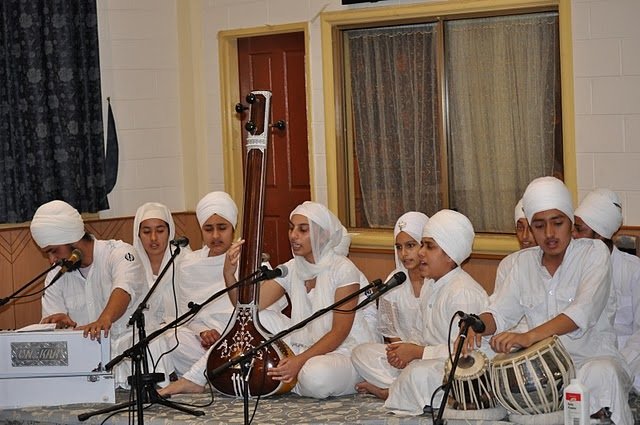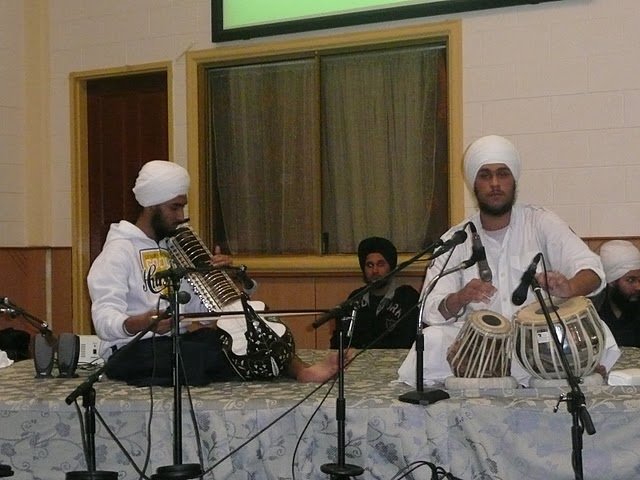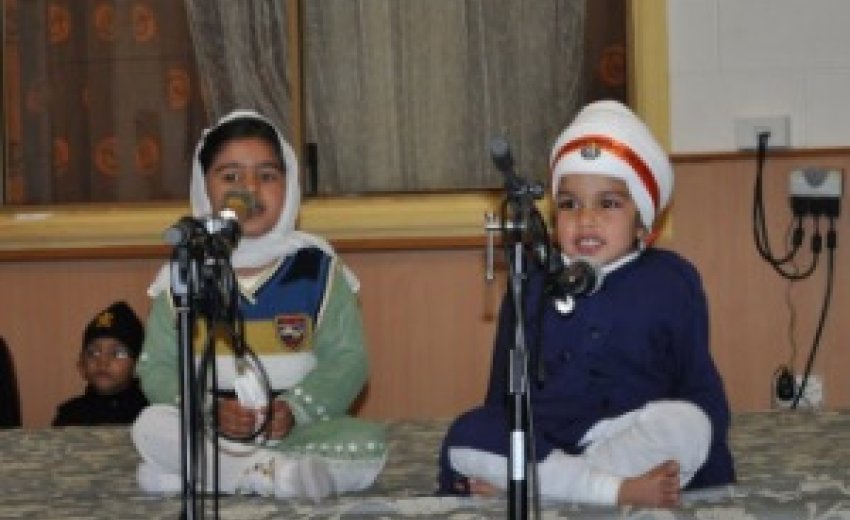Bhai Sahib Bhai Hira Singh Ji Ragi (1879-1926) memorial
9th Kirtan Shabad Gayan Mukabla at Revesby Gurdwara Sahib.
Bio - Bhai Sahib Bhai Hira Singh Ji Ragi(1879-1926): Eminent Exponent of Sikh Devotional Music
Was born in 1879 at Faruka, in Shahpur district, now in Pakistan. His father's name was Bhai Bhag Singh and mother's Satbharai. Bhag Singh was well versed in classical music and played string instruments such as sarangi and taus. Hira Singh joined the middle school at Sahival, but soon left it to study the religious texts with Bhai Mahna Singh of Faruka.
He learnt music from his father who performed kirtan in the village gurdwara. At the age of 15, he was married to Bibi Bhavan (renamed Prem Kaur). He attended the Nirankari Darbar at Rawalpindi and Namdhari Darbar at Bhaini, and subsequently joined the jatha of Sant Atar Singh in whose company he also went on a pilgrimage to Sri Abchal Nagar Hazur Sahib, Nanded.
In 1897, he settled down, with his wife, at Amritsar, working with the Khalsa Tract Society which brought him under the influence of Bhai Vir Singh and deepened his study of the Sikh scriptural writings. He started to learn playing the harmonium from Mahant Takht Singh. His father soon joined him in Amritsar and the two formed a ragi jatha, or choir, which soon became the most famous ensemble reciting kirtan at Sikh gatherings. Hira Singh led the kirtan interspersing it with exposition of the sacred verse, as his father accompanied him on the taus.
He joined the Chief Khalsa Diwan founded in 1902, and worked tirelessly towards promoting its programme of religious and social reform and of education among Sikhs. By his kirtan and discourses, he kept vast audiences spellbound. Many entered the Sikh fold under his influence.
The story is told of Haji Muhammad Miskin who was among the audience listening to Bhai Hira Singh's kirtan in Gwalior in 1925. The Haji had very diligently manufactured a rare piece of art - a whisk made of 145,000 strands of sandalwood fibre-which he desired to present as an offering at an appropriate place of worship. He felt so moved that he accompanied Bhai Hira Singh to Amritsar and, on his advice, offered the precious article at the Golden Temple. The whisk is still preserved in the Golden Temple toshakhana or treasury.
Bhai Hira Singh was one of the principal fund-raisers for the Sikh Educational Conference which set up schools in many parts of the Punjab. He helped to found in 1908 a Khalsa high school at Faruka which after the partition of 1947 was restarted in Ambala Cantonment. In the middle of 1924, Bhai Hira Singh was taken ill with cancer of the stomach. He died at Dehra Dun on 2 September 1926.
Bhai Sahib Bhai Hira Singh was one of the greatest Ragis (hymn singers) of Guru Granth Sahib. He did Kirtan of the Sikh Scriptures in the Classical Styles. He was a genius, par-excellence in Sikh history, music and Sikh Philosophy. He was a stalwart who dedicated his life to the propagating of Sikhism. He was well versed in the art of hermeneutics of Gurmat. He was the past master of classical Ragas.
He traveled far and wide to many parts of India, Burma and other countries, preaching the gospel of Sikhism. He was blessed with a melodious voice which could spell-bound and mesmerize the audiences of more than thirty thousand at a time. He was loved and respected for his disposition of the highest order by all and no Diwan was considered to be perfect without his cordial participation. He was humble and modest, and believed himself to be a true servant of the Sikh Gurus. Contrary to the modern Ragis, he was not motivated by money. He did not worship Mormonism but meditated on the Naam of Sat Guru. He was a saint, who served mankind. He was really a man of God.

He brought back to the mainstream of Sikhism thousands of people who had gone astray. He organized innumerable Ceremonies and baptised thousands of Sikhs. Scores of prominent Sikh scholars, including Bhai Sahib Bhai Vir Singh and Professor Puran Singh, have written obituaries on his untimely death, highlighting his rarest qualities of head and heart, and unfaltering faith in Sikhism. He was given many awards. In the International Sikh Seminar 1995 he was awarded a Silver Memento, posthumously, in recognition of his services to the Sikh Panth. He lived and died a true Gurmukh. The best way to remember the great Gurmukh would be to spread his values and ideas for which he lived and died.

Under the auspices of Sikh Kirtan Parchar Mission of Australia, annual Shabad Gayan Mukabla (i.e. Kirtan Competition) is organized for the young and bright souls of 'Sikh Panth'. This year 9th such competition was held in Gurduara Sahib Sri Guru Singh Sabha, Revesby on 16th and 17th of July 2010 where many children from the age of 18 months to 23 years took active part. The total number of participation that included solo singing, playing of Sikh traditional instruments and group shabads went around 100. The main focus of this competition is to play and sing in traditional ragas as are enshrined in Guru Granth Sahib but the entry is open to anyone who can sing Gurbani. Some of the young Kirtania's are well beyond the caliber of professional Ragis and will definitely shine in the field of Gurbani Singing in the coming years.
Acknowledgements - Dr Tejpal Singh Ji, Major Balwant Singh Ji
for more photos visit: http://ozsikhs.blogspot.com/
